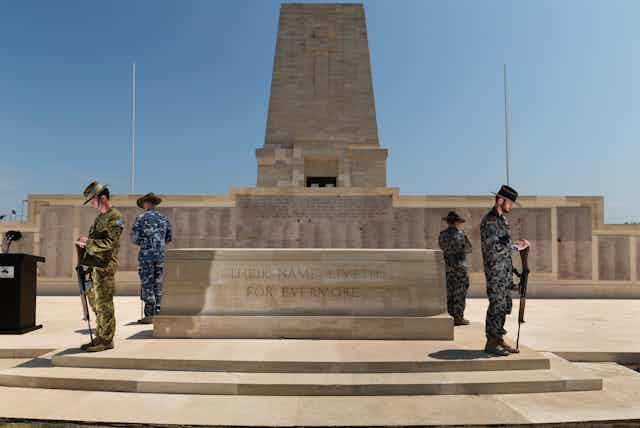November 11 resonates less with Australians than April 25. But Armistice Day provides a moment to reflect on Australia’s self-identity in comparison to other nations that experienced the first world war and commemorate it to this day.
Nations exist in a perpetual state of creative tension. They must appear to be unique: that is the basis of nationhood. However, all nations are essentially the same in form: only the content of legends, heroes and villains differ.
Australia is no different. So, thinking about Australia in comparison with others will provide a more accurate understanding of Australia’s past and soften some of the hyperbole surrounding Anzac today. And these global comparisons will enable a clearer picture of what might make Australia unique to be formed.
Ties that bind
The first world war was a truly global and transnational conflict. This makes it doubly noticeable that centenary commemorations across the world are so dominated by stubbornly national narratives.
Australia is a good case in point. When Australia went to war in 1914 it was part of “the Empire on which the sun never set”. At Gallipoli, Australians fought alongside and were cared for by men and women from Britain, Ireland, New Zealand, British India and France. Australians fought against Turks, Arabs and other peoples of the Ottoman Empire.
Relegating the global and transnational dimensions and reiterating familiar – if erroneous – national narratives creates distortions in the image of the national self.
For example, it is sometimes implied that Australia was the only nation during the war not to impose conscription on its (male) population. This leads to understandings that Australia was unique in its deployment of an army of citizen-soldiers – a sort of latter-day Athens with all of its implied virtues. As retired Chief of Army Lieutenant General Ken Gillespie said in 2014, Australia was:
… not founded on militarism; citizen soldiers forged the tradition and that legacy is in our modern Diggers and has flowed through to the population at large.
But a wider look at the history of the Great War suggests that this citizen-soldier source of uniqueness needs to be qualified in several ways. The South African government did not conscript white men for fear of provoking the Afrikaners, although there was little hesitation in conscripting African labour.
Similarly, men of the British West Indies also freely volunteered their services. But they found themselves reduced to menial and dangerous non-combatant roles when sent to the Western Front. Prevailing British racial attitudes towards “inferior races”, such as the descendants of slaves in the Caribbean, suggested that arming such men in the heart of Europe would only invite trouble – even though the French deployed thousands of men from West Africa.
Perhaps unsurprisingly, then, no official Great War commemorations are currently planned in Jamaica.
The British Indian Army recruited more than 240,000 soldiers without resorting to conscription – an endeavour that historian David Olusoga has described as “the largest volunteer army in the world”.
But we must be careful when ascribing motives for enlistment. This is as true for India as it is for Australia. Many of these men from British India were from impoverished villages and war provided the (dangerous) prospect of advancement. But this is not so different from Australia, where the motives for enlisting were various – whatever the official propaganda of the recruitment posters may have implied.
Thus, the suggestion that Australia was the only combatant nation to have free citizen-soldiers is not true. A more accurate claim would be that Australia was only one of two of the “white” Dominions not to impose conscription.
What makes Australia different
What is unique, however, is that the proposal to impose conscription was voted down twice in referendums in which men and women voted. Here is something that Australia, as a new nation-state with a reputation for social and political innovation, could offer the world as a unique moment in the history of the Great War.
It is to be hoped that after 2015 the commemorative emphasis will be less on military service and broaden to the two referendums of 1916 and 1917: a moment for the commemoration of citizenry in wartime rather than soldier-citizenry in war.
It may be that it is difficult to commemorate the intense divisions created by the conscription referendums at a time when bipartisanship rules in the rhetoric of contemporary commemoration. Nevertheless, this could be just the breath of fresh air that the potentially repetitive centenary needs. By looking more closely at others, we will understand more about ourselves.

